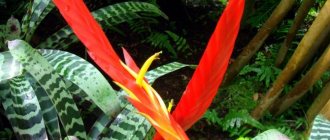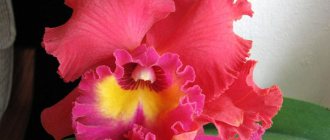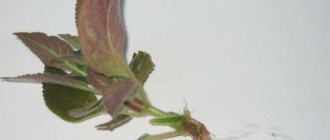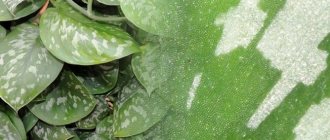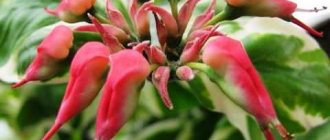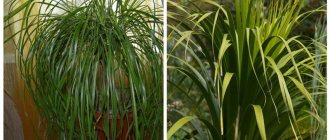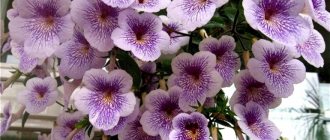This is a decorative indoor specimen no more than 30-50 cm high, characterized by long-term abundant flowering, various shades of inflorescences and original leaf color.
The homeland of Koleria is the north-west of South America; more than 60 of its species are currently known. At home, the plant has a weak growth rate, but pleases with its beauty for more than 3 years, after which the plant requires rejuvenation. Thus, the flower lives for a long time and is considered a perennial.
Be sure to pay attention to such wonderful plants as nematanthus and smithiantha.
| Low growth rate. |
| Blooms from late spring to early autumn. |
| An easy plant to grow. Suitable even for a beginner. |
| Perennial. |
Useful properties of koleria
Koleria is a safe, non-poisonous and absolutely non-allergic flower that is able to purify the air of impurities, traces of smoke, dust and toxic compounds. The plant saturates the surrounding space with oxygen, ionizes and refreshes the air.
Therefore, it can be considered an ideal option for placement in a nursery, bedroom, or kitchen.
Koleriya: care at home. Briefly
Koleria at home is such an unpretentious plant that it will delight any novice gardener. Basic nuances of flower care:
| Temperature | Not lower than 20-23 ºС in the summer season, in winter the optimal temperature is 15-16 ºС. |
| Air humidity | Requires high air humidity, at least 70%. |
| Lighting | Indirect sunlight, supplementary lighting on cloudy days. |
| Watering | Abundant moisture with soft filtered or rain water, but avoiding stagnation of moisture in the roots. |
| Soil for coloring | Slightly acidic, drained. |
| Feeding and fertilizer | Liquid fertilizing from the very beginning of the growing season. |
| Coleria transplantation | It is enough to replant once every three years. |
| Reproduction | Seeds, cuttings, leaves, as well as dividing the rhizome. |
| Features of cultivation | Should be protected from drafts and sudden temperature changes. The strong root system of Koleria can survive short-term drought. Regular pruning is required. |
Coleria flowering
Most of all types of flowers begin to bloom in early July and end in November. After this, as a rule, the plant goes into dormancy mode - the growth and development of shoots stops, flowering does not occur. However, sometimes there are species that bloom all year round. In order for the flowers to bloom magnificently and for a long time, it is necessary: a location with good lighting, nutritious soil, and timely fertilizing. We should not forget that flower stalks are rarely formed on young plants of the first year. But two to three year old specimens are quite capable of pleasing the owner with beautiful flowering.
Caring for coles at home. Details
Coleria flowering
Koleriya blooms very luxuriantly and for a long time - until late autumn.
The second name of the flower, “Colombian bell,” is fully justified by the appearance of the inflorescences in the form of elongated tubes with five petals at the ends. In addition to the rich color from rich fuchsia to soft lilac, the flowers of the koleria are “decorated” with small spots or stripes. Hybrid forms can have the most incredible shades, for example, brindle or golden color. Koleriya is ideal for overhead growing and looks great in hanging flowerpots and flowerpots. For successful flowering, it is enough to provide the plant with abundant regular lighting and a fairly tight flower container.
Temperature
Homemade koleriya is a heat-loving flower that develops safely in normal room conditions at a temperature of 23-25 ºС. With the onset of cold weather, the plant goes to winter at 15 ºС. But there are varieties that do without a resting stage and therefore, even in winter, they maintain the usual conditions of detention.
Spraying
Koleria needs high air humidity, but does not tolerate moisture getting on the leaves or flowers. That is, spraying is not the most successful option for caring for a plant.
To maintain the necessary balance of humidity in a room with a hue, it is advisable to use special room humidifiers. Or spray the space near the flower with a spray bottle.
Lighting
At home, the koleria plant prefers well-lit corners, south-facing windows with slight shading, or glazed sunny loggias. The plant is very light-loving, but it should be protected from scorching rays. In winter, the flower requires additional illumination with lamps for at least 12 hours a day.
Watering the koleriya
During the flowering period, the plant is given fairly frequent watering, but only if the soil surface has dried out a little.
Severe waterlogging also harms the flower, as does lack of moisture. In addition, watering the koleria must be done very carefully, avoiding water getting on the plant itself. As an alternative to classic watering, you can use moistening through a tray, as well as periodic loosening of the soil. In winter, watering is reduced to a minimum, only to moisten the earthen ball at the roots.
Kohleria pot
To grow koleria, experienced gardeners recommend choosing shallow, wide containers with a diameter of 20-25 cm. Very often, being in a pot that is too spacious is the reason for the lack of flowers in the plant, since in a large container the flower actively develops only the root system.
For very young varieties, pots with a diameter of 6 cm are sufficient.
Priming
The flower requires slightly acidic, loose soil, with a small amount of nutrients. If you take a home-made substrate, it can consist of the following components:
- sheet soil (2 parts)
- coarse sand (1 part)
- peat (1 part)
- humus (1 part)
Also suitable for koleria is universal soil for Saintpaulias and Gloxinias. A prerequisite is good drainage of the substrate.
Feeding and fertilizer
Koleriya at home needs systematic feeding, starting from April - the time of active development, and ending in mid-autumn. Most often, liquid fertilizer is used, containing a large amount of phosphorus, which promotes lush flowering.
Complex additives intended for orchids and violets are also suitable. All products are diluted in half the proportion indicated on the package.
Transfer
Koleriya is transplanted every three years in early spring after the end of the dormant phase.
Starting the procedure later, during the period of bud formation, is a big mistake, since in this case the flower will simply shed its ovaries and flowering will not take place. It is recommended to replant using a transshipment method, without shaking off the rhizomes and, if possible, without disturbing the earthen lump.
Trimming
Koleria is a universal flower that looks equally good both in the form of a bush and as an hanging plant. You can give it the desired look with the help of regular pruning, which not only shapes the crown of the flower, but also rejuvenates it. Basic rules for pruning:
- carried out in the spring, before the beginning of the growing season;
- damaged or dried shoots are removed with a sterile instrument;
- when the erect form of the flower is formed, all branches that have reached a length of 20-30 cm are shortened by about a third;
- To stimulate the growth of young lateral shoots and, accordingly, the formation of more buds, it is recommended to shorten all the tips of the shoots.
Timely pruning will increase the number of inflorescences and give the flower a well-groomed appearance. And on the contrary, if you exclude this measure, the branches of the plant will stretch out unsightly, and there will be significantly fewer flower stalks.
Rest period
Caring for koleria at home often involves providing the flower with a dormant period - the time when the plant stops growing and sheds its foliage in order to restore strength for the next development cycle. Depending on the variety, some varieties overwinter together with the foliage, bloom and require regular watering, while there are those that require complete rest - no fertilizing, extremely rare soil moisture.
If, with the onset of cold weather, the leaf turgor of a flower changes and begins to dry out, this plant needs rest. All wilted areas are completely removed, the bush is placed in a cool, moderately lit place, and until January, caring for it only includes lightly moistening the earthen clod.
Features of cultivation
Temperature
Koleria prefers moderate temperatures. In summer 20-25 degrees C. If the plant stops flowering, i.e. enters a dormant period, it is better to reduce the temperature to 15 - 17 degrees C. When choosing a place for the garden, you must take into account that it does not like drafts.
Lighting
Koleria is a light-loving plant. She needs a well-lit place, but in summer it should not be hot there and she should not be exposed to direct sunlight. During the dormant period, if the koleriya has not dropped its leaves, it also needs to be provided with good lighting.
Watering
During the period of growth and flowering, i.e. from spring to autumn, watering should be done moderately. The soil should not be over-moistened, but drying out is also undesirable. In winter, watering must be reduced even more. If the above-ground part of the plant has died during the winter, the soil with the rhizome must also be periodically lightly moistened so that the rhizome does not dry out.
Air humidity
Koleria can grow in dry air, but prefers a humid microclimate. However, its velvety leaves do not tolerate drops of water falling on them. Therefore, to create high humidity, it is necessary to spray not the plant itself, but the air around it, and also place the container with the color in a tray with wet moss or expanded clay. For watering and spraying, it is better to use soft, warm water.
Transfer
For transplantation, use wide and shallow containers. Drainage must be provided. It is recommended to replant every year; the variety grows greatly over the course of a year.
Fertilizer
Koleriya is fertilized during the period of active flowering, from April to August, with special fertilizers for flowering plants. Feeding is done once a week. During the dormant period, the plant does not need to be fertilized.
Growing Koleria from seeds
It is worth considering that when propagated by seeds, a flower most often does not retain its varietal characteristics. It is recommended to sow koleria in February. To do this, flower seeds are distributed into a low, wide container with special soil for Gesneriaceae without embedding.
Then the crops are covered with polyethylene or a glass cap, placed in a warm place and after the first shoots appear, daily additional lighting is organized. If there are several strong leaves, the plant is planted in separate pots with a diameter of 6-7 cm. Before the bush is formed, the seedlings should be pinched at the tops to stimulate the growth of side shoots.
Propagation of koleria by cuttings
A simple and quick option for breeding koleria is propagation by apical shoots. For this purpose, the cut tops of the bush are treated with stimulants and placed in a special soil, or a peat-sand mixture of about 2 cm. After 14 days, the first roots appear, and in a month it will be a full-fledged plant with a developed root system.
Since the “Colombian bell” is characterized by a high rate of root formation, the flower takes root successfully in water.
Pruning Koleriya
Pruning Koleria is considered a hanging plant, but can also be grown in the form of a neat bush. In any case, whatever shape is chosen, it must be constantly maintained by trimming and pinching the Colombian beauty. If the flower is not given due attention, the shoots will become very elongated, sagging from their own weight, lose foliage, and form fewer peduncles. Trimming and forming the crown of the kohleria step by step:
First of all, it is necessary to remove dried, broken or diseased stems; Then you should decide what kind of plant you want to get as a result of the formation of the crown - upright or hanging; The next stage is preparation and disinfection of instruments (knife or scissors). You can disinfect the blades of instruments by briefly holding them over the fire or wiping them with alcohol; If the goal is to get a lush compact bush, you should cut off all elongated (20-30 cm) shoots by about a third. When the top of the stem is removed, the axillary buds awaken, branching and the formation of new young shoots occur. This will give the plant a more spreading appearance. The cut off tops can be used for subsequent rooting and propagation of flowers.
Propagation of coleria by division of rhizomes
When transplanting a flower, you can try to propagate it by dividing the root - the rhizome. The rhizome of a healthy adult plant is suitable for this, since it has several buds, nodes, and scaly growths that can produce full-fledged shoots when divided.
Having divided the rhizome into several parts, each of them is sprinkled with coal and allowed to dry. Then the roots are planted in separate containers and watered regularly. This method of propagation allows you to obtain a stronger, stockier, profusely flowering plant that is not prone to stretching.
Transplantation and propagation
When transplanting into prepared containers with earthen mixture, you must first install a drainage system in them.
The roots are carefully removed from the old pot along with the earthen lump and transplanted into a new one, usually a wider one. This procedure must be done annually.
Reproduction is done by seeds, cuttings and root division. For Kohleria, buying seeds in specialized stores is not difficult. However, the most common method is still dividing a healthy, strong rhizome into pieces.
The best time for this is mid-spring. The separated parts of the root are placed in the soil mixture and gently watered, waiting for rooting and the appearance of stems. After that, the plant is cared for as usual.
Diseases and pests
The main problems that gardeners face when growing flowers are:
- koleria does not bloom in a pot that is too spacious, or when there is insufficient light;
- dark spots on the leaves will appear when watering with hard or cold water;
- Kohleria leaves turn pale or yellow as a result of poor lighting and frequent drafts;
- Kohleria leaves curl in rooms with low humidity;
- leaves wither when rotting areas appear in the root system, this may also be a signal that the plant requires a period of rest;
- light spots on the leaves (powdery mildew) - a fungal disease that often appears in conditions of high humidity or an excess of nitrogen fertilizers;
- gray plaque on the leaves (oidium) is caused by a fungus that spreads throughout the plant due to sharp fluctuations in temperature and humidity;
- koleria often drops buds due to excess calcium;
- Koleria shoots became bare due to an acute lack of sunlight;
- grows slowly, buds fall off when there is a lack of nutrients in the soil;
- Koleria leaves turn yellow if the flower is often exposed to the rays of the scorching sun, or if there is an oversaturation of fertilizers.
Pests of Koleria are aphids, mealybugs and spider mites.
Description of the Koleria plant
Kohleria is a perennial plant in the form of herbs and shrubs belonging to the Gesneriaceae family.
The genus contains about 65 species. Distribution area: South, Central America and Mexico.
The root system is a scaly tuber. Foliage in the shape of an elongated oval. The main color of the leaf blades is dark green, and depending on the species, it has variegated inclusions and pubescence. The flowers are bells with a long tube that branches into 5 petals. The inflorescence may include from one to three buds. The color range is very diverse and in most species the main color of the flower is diluted with splashes of other shades.
Types of domestic varieties with photos and names
Koleria is a little popular flower in our latitudes. But still, the following varieties are common in indoor floriculture:
Kohleria amabilis (lat. Kohleria amabilis)
The flower is characterized by brown-green foliage with silvery fibers, shoots 40 cm long, and speckled petals of all shades of pink.
Linden's Kohleria (lat. Kohleria lindeniana)
A fairly compact type of plant, 20 to 30 cm high, with two-color foliage and contrasting veining, large light lilac flowers up to 6 cm in size.
Fluffy-flowered kohleria (lat. Kohleria eriantha)
It has rich green leaves with dark red edges and orange or purple buds that point downward.
Hairy Kohleria (lat. Kohleria hirsuta)
It is distinguished by purple-tinged foliage, as well as red flowers with a yellow border along the edges of the petals.
Kohleria bogotensis (lat. Kohleria bogotensis)
The tallest plant among the kolerias - up to 60 cm in height, with white-red pubescent shoots, single or double axillary red-orange inflorescences with a yellow throat.
Botanical description
The Gesneriev family includes approximately 65 species of plants of the genus Kohleria . They grow mainly in territories from Central America to Mexico, on the island. Trinidad and Colombia. This genus got its name in honor of the famous teacher in the 19th century in Zurich, Michael Kohler. Kolerii are not particularly demanding on temperature and humidity, so they are easier to grow than other plants of the Gesneriev family. Koleria are subshrubs and herbaceous plants that grow for several years and have a scaly root-tuber. The leaves on the petioles are arranged oppositely, elongated in length and have an ovoid shape. The surface of the leaf is densely covered with pile, and the leaf itself will grow up to 15 cm in length and up to 8 cm in width. Some species have red veins on dark green leaves, while others have a light main vein, and the leaf itself is a dark olive shade. The leaves are ribbed and shiny; the pile on the leaves is white or red. Hybrids may have bronze or silver colored leaves. Indoor flowers are very profusely flowering plants. Flowers grow one at a time or two or three flowers located on an axillary peduncle. The tube of the corollas reaches 5 cm, narrows towards the throat, slightly widens downwards; The corollas themselves are shaped like bells. The pharynx is wide open and has 5 blunt lobes, which are covered with dots, spots and streaks. In nature, Koleria flowers have a variety of colors: red-orange flowers with dark red spots on a yellow throat; pink flowers with dark pink dots on a white throat; brown flowers with white dots, and a pink pattern on a white throat.


